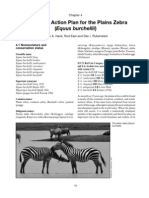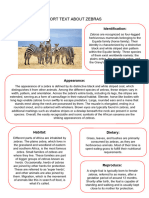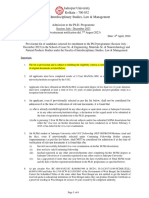0% found this document useful (0 votes)
155 views3 pagesZebra: For Other Uses, See
Zebras are African equines distinguished by their black and white striped coats. There are three living species - Grevy's zebra, plains zebra, and mountain zebra. Zebras share the genus Equus with horses and asses. They inhabit eastern and southern Africa across various habitats and subsist on lower quality vegetation. Zebras communicate through vocalizations, body postures, and facial expressions to strengthen social bonds. Their stripes provide protection from flies and make them among the most recognizable mammals.
Uploaded by
Andrijana MilovanovicCopyright
© © All Rights Reserved
We take content rights seriously. If you suspect this is your content, claim it here.
Available Formats
Download as DOCX, PDF, TXT or read online on Scribd
0% found this document useful (0 votes)
155 views3 pagesZebra: For Other Uses, See
Zebras are African equines distinguished by their black and white striped coats. There are three living species - Grevy's zebra, plains zebra, and mountain zebra. Zebras share the genus Equus with horses and asses. They inhabit eastern and southern Africa across various habitats and subsist on lower quality vegetation. Zebras communicate through vocalizations, body postures, and facial expressions to strengthen social bonds. Their stripes provide protection from flies and make them among the most recognizable mammals.
Uploaded by
Andrijana MilovanovicCopyright
© © All Rights Reserved
We take content rights seriously. If you suspect this is your content, claim it here.
Available Formats
Download as DOCX, PDF, TXT or read online on Scribd
/ 3


























































































